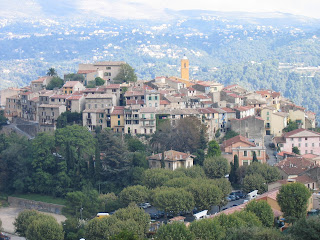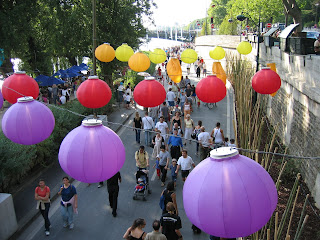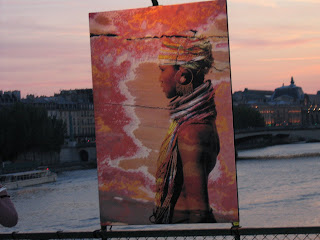Attending the meeting on debt swaps for education provided me with a perfect opportunity to finally visit Buenos Aires. The vibe of the city made me wish that the visit lasted longer. It is strange how many parallels one can find between Paris and Buenos Aires. No wonder the city is called Paris of Latin America. I could easily see that Buenos Aires in Latin America is what Paris is in Europe. Both cities have diverse neighborhoods, beautiful architecture, great shopping, gourmet food, café culture, cultural opportunities as well as fashion conscious and proud inhabitants.
Most of Argentinians have strongly European, including Italian, German and East Europian jewish, origins. Portenos, Buenos Aires inhabitants, like Parisians, are proud, individualistic and stylish but friendlier. Young people follow most recent trends and older people exhibit class and style from old times. Ladies wear fur coats and elaborate hats and men - cashmere coats, silk scarves and sombreros. This pre-war elegance does not exist anywhere else.
Portenos and Parisians are crazy about dogs so there is the same problem of dirty streets. One can see many large dogs around Buenos Aires. It is much easier to afford keeping a large dog in Buenos Aires than in Paris since it is possible to hire a special dog walker. I saw many of them walking ten dogs or so on a leash at the same time! I am not aware of such service in Paris so maybe that is the reason that Parisians tend to have much smaller dogs.
 Both French and Argentineans are passionate about soccer so it was interesting to watch the final game of the Latin American Cup between Argentina and Brazil at a local bar. For Argentineans, it was a matter of honor to win so they were cursing and slamming the table when the game was not going as they expected. As a contrast, there was a group of Brazilians sitting quietly and drinking champagne as if they knew an outcome of the game. Unfortunately, I did not get to witness Argentinean victory and see the celebration in the streets. I only saw Argentineans sulking the same way as Parisians were after the final of the World Cup 2006.
Both French and Argentineans are passionate about soccer so it was interesting to watch the final game of the Latin American Cup between Argentina and Brazil at a local bar. For Argentineans, it was a matter of honor to win so they were cursing and slamming the table when the game was not going as they expected. As a contrast, there was a group of Brazilians sitting quietly and drinking champagne as if they knew an outcome of the game. Unfortunately, I did not get to witness Argentinean victory and see the celebration in the streets. I only saw Argentineans sulking the same way as Parisians were after the final of the World Cup 2006.
 Like Paris, the best way to see Buenos Aires is to walk everywhere so this is exactly what I did. It helped to experience the atmosphere of Buenos Aires' diverse neighborhoods. Colonial architecture makes one really feel in Europe. In Palermo Soho, which reminded of Soho in New York, I enjoyed having lunch outside while watching people and explored trendy boutiques. Starting in this neighborhood, avenida Sante Fe was a long street with many shops and crowds of people stumbling out of them. An interesting sight was a huge bookstore El Atheneo (corner of Santa Fe and Callao) which was established in an old movie theater with an artwork ceiling.
Like Paris, the best way to see Buenos Aires is to walk everywhere so this is exactly what I did. It helped to experience the atmosphere of Buenos Aires' diverse neighborhoods. Colonial architecture makes one really feel in Europe. In Palermo Soho, which reminded of Soho in New York, I enjoyed having lunch outside while watching people and explored trendy boutiques. Starting in this neighborhood, avenida Sante Fe was a long street with many shops and crowds of people stumbling out of them. An interesting sight was a huge bookstore El Atheneo (corner of Santa Fe and Callao) which was established in an old movie theater with an artwork ceiling.
 Due to a recent economic crisis, shopping in Buenos Aires is "dangerous" since many things, including luxury and designer goods, are much cheaper than in Europe. In one store where I commented that clothes have similar style and quality as the ones in Parisian boutiques, the flattered owner gave me a present. Many tourists buy leather stuff in Buenos Aires, one of the better quality brands being Navarro. A taxi driver took me to a Navarro store even though I said that I have no need for a leather jacket. Apparently, leather jackets, shoes and bags are prepared for the western market so only Argentineans come there to shop. As for souvenirs, I bought mate containers with bombilla, a small metal straw used as a filter, and mate leaves. Traditional mate is a social drink, which tastes like tea and is drunk from the same mate by family/friends anytime throughout the day.
Due to a recent economic crisis, shopping in Buenos Aires is "dangerous" since many things, including luxury and designer goods, are much cheaper than in Europe. In one store where I commented that clothes have similar style and quality as the ones in Parisian boutiques, the flattered owner gave me a present. Many tourists buy leather stuff in Buenos Aires, one of the better quality brands being Navarro. A taxi driver took me to a Navarro store even though I said that I have no need for a leather jacket. Apparently, leather jackets, shoes and bags are prepared for the western market so only Argentineans come there to shop. As for souvenirs, I bought mate containers with bombilla, a small metal straw used as a filter, and mate leaves. Traditional mate is a social drink, which tastes like tea and is drunk from the same mate by family/friends anytime throughout the day.
On the way to Recoleta, I tried dulce de leche flavor of the famous Argentinean ice cream El Freddo. Recoleta, an elegant district with aristocratic and luxury houses, is a home to the cemetery where Eva Peron is buried and Plaza Francia which is usually filled with craftsmen, musicians, live statues, etc. The shopping pedestrian Florida avenue with Galeria Pacifico, a shopping center I found interesting because of art pieces on display, led me towards San Telmo neighbourhood. During the weekend, I stayed there at a boutique hotel with an authentic atmosphere, called Lina's Tango House, where people have an opportunity to learn how to dance tango. San Telmo is known for its tango clubs as well as Sunday antiques fair and tango and other street performances around Dorrego Square.


 For more prevailing tango atmosphere, it is also worth visiting La Boca neighborhood with its pedestrian street Caminito, the name of which was inspired by a famous tango. The houses on this street are made of metal sheets painted in different bright colors.
For more prevailing tango atmosphere, it is also worth visiting La Boca neighborhood with its pedestrian street Caminito, the name of which was inspired by a famous tango. The houses on this street are made of metal sheets painted in different bright colors.

Good quality and delicious food is another reason why Buenos Aires reminds of Paris. The most popular meal in Argentina is
el asado or
parillada, a mixed grill of steak and other cuts. Traditional
parillada includes meat, sausages, chinculines (lower intestines), rinones (kidneys) and morcilla (blood sausage) accompanied by chimichurri, a tasty marinade. In Argentina, some cuts of beef and its flavor are quite different from the ones available in Europe or North America.
The best steak I had was at a restaurant in
Las Canitas, a gastronomic neighborhood of Buenos Aires
. Lomo tenderloin, one of the best and most expensive cuts, was so tender and juicy that it was literally melting in the mouth. Argentinean Malbec wine and parmesan salad accompaniment made the meal even tastier. I was told that Argentineans themselves prefer
Bife de Chorizo, which is sirloin and not as tender as Lomo, but supposedly has more flavor.
We also went to
La Chacra, a typical parilla restaurant, where we tried a variety of meat cuts, however, the restaurant was more touristic since it was well advertised. Almost every day, I savored delicious
empanadas filled with ground meat, olives, boiled egg and spices. What surprised me was that in Buenos Aires people eat quite late, after 10pm, then have drinks and go out to a party or dancing at 3am. No idea how it is possible to function at work next day. Maybe portenos have difficulty in falling asleep after stuffing on beef cuts :)
Also, the nightlife in Buenos Aires is so exciting that it would be a crime to sleep early. During the national day of the traditional tango instrument
bandoneon, we were privileged to see the tango show at Torcuato Tasso Cultural Center performed by most renowned Argentine artists, Seleccion Nacional de Tango and musicians who played in Anibal Triolo's orchestra. An emotional atmosphere was created with older generation musicians from the tango orchestra passing their craft to the younger generation and the crowd singing popular songs along. We had an opportunity to hear Suzana Rinaldi sing, who is a world renowned tango singer and a UNESCO Goodwill Ambassador.
An interesting observation is that although nowadays tango is so valued, its roots weren't so glamorous. In the end of 19
th century, tango music originated in Buenos Aires' brothels frequented by immigrants made up by sailors, craftsmen and working class from Europe who left their families in search of new opportunities. In the beginning, tango was danced by men only and women were added later. At present, tango revival is taking place in Buenos Aires. Young and old portenos take lessons and dance Argentine tango into wee hours in
millongas. I was so inspired that when I came back to Paris I started taking tango lessons, which are offered for free on the banks of the Sienne in summer months. Here is another Paris-Buenos Aires connection. It was Paris and not Buenos Aires that made tango popular among higher classes.
Buenos Aires and Argentina really fascinated me so I was eager to learn more about it when I came back to Paris. I went to see a movie
Buenos Aires 1977 about military junta which captured and tortured young people who supposedly were in opposition. I was really shaken because a movie, based on a real story, was mostly about what the prisoners were going through daily, their torture and final escape. Following a prosperity from 1880 to 1945 when Argentina became one of the top 10 richest countries in the world and then the presidency of Juan Peron, who tried to empower the working class, the armed forces seized power from 1976 until 1983. Opposition repression, dissident disappearance, cooperation with the US intelligence and Army, defeat in the Falkland War, growing corruption, increase in foreign debt, conditions imposed by creditors and IMF, brought by this military dictatorship caused disastrous economic problems.
Restored democracy in 1983 did not solve them. Hyperinflation, growing fiscal deficit and government policies that did not work resulted in the culmination of economic crisis, debt default and chaotic climate in 2002. Newly elected president Nestor Kirchner in 2003 took positive restorative steps, including restructuring country's defaulted debt and paying off outstanding IMF debt, which brought Argentina back on track of economic growth and political stability.





























 As a dominotreaux, she splashed a wip at the dancers dressed in leather and then turned over in a saddle on the side of the stage. Her shocking appearance on a rising cross and the images of children around the world implied that without help these children will die. Touching messages said: "I was hungry and you gave me food, I was naked and you gave me clothing, I was sick and you took care of me." Next, she went for a political implication by joining hands of two men with Palestinian and Israeli symbols depicted on their chests. Another message came about when a Muslim man started traditional singing and a woman dressed in burka struggled to get out of a cage. When she managed - a long dark haired beauty in gold decorated clothes appeared. More images of political and military leaders appeared with a message DON'T TALK. The rest of her repertoire was songs from her old albums and dance songs from the newest album, each of them accompanied by a different show theme.
As a dominotreaux, she splashed a wip at the dancers dressed in leather and then turned over in a saddle on the side of the stage. Her shocking appearance on a rising cross and the images of children around the world implied that without help these children will die. Touching messages said: "I was hungry and you gave me food, I was naked and you gave me clothing, I was sick and you took care of me." Next, she went for a political implication by joining hands of two men with Palestinian and Israeli symbols depicted on their chests. Another message came about when a Muslim man started traditional singing and a woman dressed in burka struggled to get out of a cage. When she managed - a long dark haired beauty in gold decorated clothes appeared. More images of political and military leaders appeared with a message DON'T TALK. The rest of her repertoire was songs from her old albums and dance songs from the newest album, each of them accompanied by a different show theme. The popular high-energy song "Time goes by" finished the spectacular show with words appearing on the screen "Have you confessed?
The popular high-energy song "Time goes by" finished the spectacular show with words appearing on the screen "Have you confessed?













